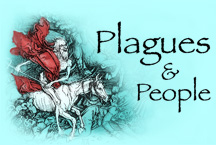
Infectious and Epidemic Disease in History
Department of History
University of California, Irvine
Instructor: Dr. Barbara J. Becker
News Articles from the Chicago Tribune |

Department of History
University of California, Irvine
Instructor: Dr. Barbara J. Becker
News Articles from the Chicago Tribune |
|
|
|
- August 20, 1893 - THEY DEAL IN DEATH.
BITS OF ORGANIC MATTER THAT
How Diphtheria, Malaria, Pneumonia, Typhoid-Fever, and Asiatic Cholera Microbes Look and Act--Methods of Checking and Controlling the Diseases They Introduce into the Human System--Value of Vaccination as a Means of Prevention. It is almost a "fad" nowadays to speak of microbes and bacteria.
The most uneducated layman knows that cholera and pneumonia are caused
by micro-organisms, small beings invisible to the naked eye. Still,
bacteriology as a science has been in existence only a short time.
The mere statement that cholera and pneumonia are caused by microbes implies
that there must be different kinds of microbes, that the microbe of cholera
must have specific and characteristic properties, and that these properties
must be essentially different from those of the microbe of pneumonia.
This shows that the world of micro-organisms is composed of species like
the rest of living nature. Now that we know these facts this all
seems natural enough. Yet they were only acknowledged as facts a
few years ago after a hard struggle with prejudice and ignorance, and after
a man like Pasteur, successfully combating against the almost insurmountable
difficulties that presented themselves at every step to the investigator,
proved the absurdity of the old doctrines and the correctness of his theories
by a series of simple but effective and convincing experiments.
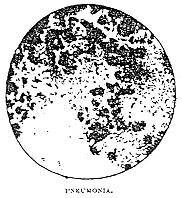 Small organisms it was thus proved cause sickness. But how do they act? How can such infinitely small creatures cause such radical and pernicious revolutions in otherwise strong systems? Suppose that a microbe has entered a system and begun its work. It has two desires and aims in life. It wants to multiply and feed. Its means of propagation are at once rapid and simple. After it has grown to a certain length it divides in the middle. The two thus created soon form four, and so on. A light idea of the rapidity of this growth, which under favorable circumstances can even be observed under the microscope, and of the terrible effect it would have if there were not numerous agencies constantly active to counteract it may be derived from the following figures and calculations: Suppose a microbe divides into two during the course of an hour.
Those divide into four after two hours, into eight after three hours, etc.
When twenty-four hours have passed the number of microbes attains the formidable
sum of 62,500,000. In two days there are 287,500,000,000. After
a week their number could only be expressed by a figure of fifty-one periods.
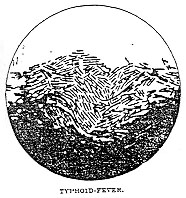 The second desire of the microbe is to feed, as has been said. They feed on tissues and blood, but their power does not lie in this. They poison. Each microbe has the faculty of secreting a certain poison in the system at the place where it vegetates. These parasites by their process of life bring about a decomposition of the substance they have fastened upon and these decompositions (the products are called ptomains or toxines) have specific poisoning effects on our system. The symptoms of this poisoning are identical with the symptoms of the disease of which the microbe is the generator. It can easily be proved that it is by the action of these poisons exclusively that the disease is caused. If, for instance, one cultivates the isolated microbe of cholera, under conditions favorable to its growth in some nutritive liquid at the right temperature for a certain length of time, it will decompose the nutritive liquid, which thus takes the place of tissues, and thus form a certain quantity of its specific poison. If by filtration or some other means the microbe is separated from the secreted poison, so that the poison may be employed free from any organism, and a small dose of this poison is injected into the abdomen of an animal, in a short time the animal will succumb, exhibiting all the signs of Asiatic cholera. How can this mysterious and invisible foe be successfully grappled with?
The most simple suggestion seems to look for something that will destroy
the microbe, the direct cause of disease, even after it had taken strong
foothold in our system. A long and patient course of experimenting
will undoubtedly bring to light a number of substances, each capable of
destroying a certain species of microbe, without at the same time, harming
the system. At present only a few such substances are known, and
these were found by chance. For instance, everybody knows that corrosive
sublimate and jovoforme are capable of destroying the germs of suppuration
and of wound fever. These are, in consequence, extensively used in
surgery as aseptics and antiseptics.
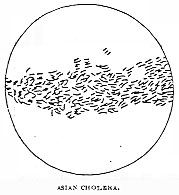 Another simple suggestion for killing microbes in the system could be based on the fact that certain micro-organisms perish at a temperature only a few degrees above the normal temperature of our body. Why not, therefore, when the first symptoms of a disease brought about by such microbes appear artificially raise the patient's temperature a few degrees, so killing the germ and preventing the disease? Some of these methods have been satisfactorily tried. At present, however, there is a better means that has already given splendid results and is destined to astonish the world. Vaccination against cholera, pneumonia, typhoid-fever, etc., is now only a question of time. It may be a few years only before a child can be vaccinated against every infectious disease and be thus protected for life against the greatest danger that constantly threatents [sic] humanity. One of the chief difficulties in all these examinations is that man
cannot be experimented on. Now and then a courageous scientist, thoroughly
convinced of the correctness of his ideas, will experiment on himself.
He will vaccinate himself against a certain disease and then try by all
possible means to contract it. If he fails to get it it proves, of
course, that his vaccine is good. All experiments on man made in
this direction have so far proved successful. Science happily has
no martyr in this cause.
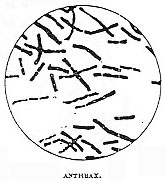 Certain animals cannot contract certain diseases. They possess a natural immunity. For instance, it is impossible to give a chicken pneumonia, although a mouse will readily take it. This immunity can be a specific and characteristic property of a whole species, that as a rule is liable to take a disease, do not contract it. This is called individual immunity. These conditions hold true where the human race is concerned, too. There are undoubtedly many hundreds of individuals out of every million of men who could not take cholera if they tried. Just here lies one great drawback to all conclusions drawn from vaccinations on man. It is always possible that the few who are vaccinated had an individual immunity and would not have contracted the disease even if they had not undergone vaccination. This individual immunity can undoubtedly also be acquired. A child that has passed through scarlet-fever is protected from a fresh attack for life, except in a few unusual cases. This long known fact, together with a series of experiments, led Pasteur to those researches on preventive vaccination which promise so much. Pasteur's first discovery in this direction was this: He had found that chickens, which are susceptible to a disease called "chicken-cholera," and which, without exception, die if a chicken-cholera microbe is injected under their skin, only have a slight and rapidly passing attack, if microbes that have been in contact with the air for some months are injected. After the chicken on which Pasteur experimented had regained its natural strength and normal condition he made a second injection with ordinary microbes that had not been in contact with the air long. He found the chicken had acquired perfect immunity against the disease, large quantities of very active microbes exercising no effects whatever. Pasteur at once saw the close analogy between this case and the case of a person who after passing through one attack of scarlet fever is protected against a second one, and basing his work on this first fundamental observation built up his whole system. By long contact with the air the microbes, which had given immunity to the chicken, had lost a great deal of their virulence, they had been weakened. The next thing to be done was to weaken the virulence of the different
kinds of microbes, to inject them, cause a slight affection, and thus bring
about an artificial immunity. This has been tried for almost every
known disease and in almost every case with satisfactory results, especially
in animal diseases, where extensive experimenting is possible. At
the present day in France thousands of sheep and horses and cows are vaccinated
yearly against a great number of diseases.
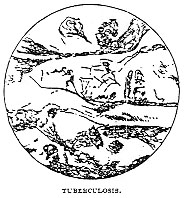 In the course of their examinations the men at the Pasteur Institute found many other means besides the contact with the air for weakening the virulence of thee different kinds of microbes. High temperature, long dryness, chemical action, strong light, and possibly, electricity have this effect. It may be stated as a general rule that the virulence of a microbe is diminished when it is put into conditions differing from its ordinary conditions of life and contrary to its nature. Thus a microbe which is accustomed to live at a low temperature and in the dark will lose a great deal of its activity if placed into brilliant light and at a high temperature. A general degeneration ensues, and its decomposing and poisoning faculty is diminished. A great many questions naturally presented themselves after these facts
had been established. What changes does the system undergo when weakened
virus is injected so that it can subsequently support great quantities
of unweakened virus that would ordinarily destroy it? What becomes
of the weakened virus in our normal system and what of the unweakened,
poisonous virus in our immunized system? Satisfactory answers have
not as yet been given to these questions. It may take a long time
before the mysterious workings of these infinitely small beings are fully
understood. Pasteur believes that a passage of weakened virus deprives
the system of certain nutritive elements essential for the existence of
this same species. Chaveau believes in the secretion of certain decomposition
products that impede forever any further development. Metschinkoff,
a Russian savant, has created a famous "phagocyte" theory which assumes
a sanitary police organization in our body. The white corpuscles
of the blood, he says, have a strong anti-microbian power. At first
invasion of weak microbes they can can exercise their strength, learn to
know their enemy, and thus be well prepared against a second invasion of
stronger microbes. All these ideas are, however, only theories.
Little has been proved. The ultimate solution will probably be made
by chemistry.
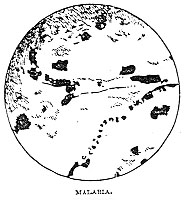 After what has been said it will be easy to understand the principle on which the world renowned Pasteur method of vaccination against hydrophobia is founded. Hydrophobia is a disease of the nervous system, consequently the microbe or poison causing the disease should be found in the brain and spinal cord. Strange to say, the microbe of hydrophobia has not yet been discovered, although its existence seems certain. At all events its presence in every case has been assumed and Pasteur operated on this assumption. If a part of the brain or spinal cord of a dog who has succumbed to the disease be taken and injected into another dog this animal will become made in a short time. If, however, the poison be weakened by placing it in contact with the air and a part of it be injected in a dog he will, after experiencing a slight attack, acquire perfect immunity and will remain insensible to repeated injections of active virus. The method of experiment employed today is based on the following principles:
The dried spinal cords of rabbits that have died of hydrophobia given them
artificially by injection are used as vaccines. The rabbit is dissected,
the spinal cord taken out and placed in a jar, at the bottom of which is
a substance that absorbs its moisture. After a few days the virulence
has greatly diminished and after a fortnight the poisonous effect have
almost totally disappeared. If a man has been bitten by a made dog
it generally takes some time--a week, a month, sometimes years--before the
poison reaches the nervous centers, where alone it seems to be dangerously
active. The time between the biting and this period, which heretofore
was invariably spent in helpless inactivity and dread suspense, is now
usefully employed in giving the patient artificial immunity. When
the patient comes to one of the "Pasteur Institutes," that now exist in
every civilized country, he is at first vaccinated with weak virus (dried
spinal chord fourteen days old), then on every successive day with stronger
virus, until after ten days or two weeks the strongest virus, that would
ordinarily poison him, can be injected without exercising the slightest
influence. By this time the virus introduced into the system by the
dog's bite has lost its poisoning power and the patient is saved.
This treatment is recognized as effective all over the world, though only
practiced since July 6, 1886.
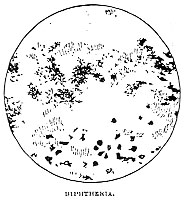 In view of the cholera danger which seems to be hovering over the world again, a few words about the progress of vaccination against this most dangerous and terrible of all epidemic diseases seem timely. The first man to try vaccination against cholera was a Spaniard, Dr. Feran. He went to work most unscientifically. He made use of his knowledge more for making money than to do good, kept his treatment a secret and placed himself on a bad footing with the scientific world in general. The consequence was that the great opposition arose against him and his methods, so that ultimately he was forbidden to practice. After him several others have found vaccines and methods of vaccination, but all seem to be virtually the same as Feran's. To him, therefore, must be given the credit of discovering a good method, which has been scientifically examined and found to be efficacious. Dr. Haffkine at the Pasteur Institute last year made some more experiments, and a few months ago published a few notices relating to his work. He found a means of weakening the microbe of cholera and discovered that after vaccinating himself with this weakened virus he had obtained perfect immunity against the disease. He tried many means of taking the disease, injecting strong and active virus, but without any results whatever. After observing a number of other cases he expresses his opinion that the problem is solved. A German named Klemperer also vaccinated himself and found that his immunity was so great that an injection of a trace of his blood to an animal conferred immunity on it in turn. No absolute surety has yet been obtained, because statistics on a large scale are wanting. They may, however, soon be forthcoming, as Mr. Haffkine has expressed his intention of practicing his vaccination in Siam on large numbers of patients. One thing is certain. Vaccination itself is perfectly harmless and without danger. The slight discomfort felt during a few hours is insignificant and the immunity acquired against cholera apparently absolute. |
|
- November 23, 1893 - CAUSED BY MICROBES.
FACTS SHOWING THAT PARASITISM
The Modern Progress of Medical Science and Discovery--Inflammations Evidence of Bacteria--Maladies That Run a Regular Course--Each Disease Has One Cause and Must Have One Remedy--Bastian's Mistake and Tyndall's Discovery of the True Law. By Leslie E. Keeley, M.D., LL.D.: Until within fifteen years the medical profession did not know the cause of disease. This fact seems incredible and it is a confession to admit it that few care to make. Within that time Pasteur, Koch, Steinberg, and many other workers in the field of microscopic research demonstrated that the microbe causes disease. Pasteur's clearest verification, perhaps, was the proof that the bacillus anthracis is the cause of anthrax or the splenic fever in the lower animals and man. Within fifteen years Dr. Koch overturned all medical theories, guesses, doctrines, and pretenses by his demonstration that bacillus tuberculosis is actually the cause of consumption and all tuberculous diseases. Bastian's Mistake. The reason why the real cause of disease remained unknown for ages, generations, and centuries of time and medical practice was because the microbe is a microscopic parasite, very difficult to discover and learn anything about. But it was finally discovered. For many years after its discovery, or after the first bacterium was actually seen, no one believed that such an insignificant organism could cause disease. In fact, no one had the least conception of the idea of parasitism in general or particular in relation to disease. It was known that parasitism was a biological principle, but none thought, at least the profession did not think or believe, that parasitism is the great pathological force which underlies the phenomena of disease, as essentially causative in this relation as the force of gravity is to the phenomena of astronomy. A short time previous to Dr. Koch's discovery that consumption is caused by a germ a Dr. Bastian was making some remarkable experiments with a microscope. Dr. Bastian was not working particularly as an investigator of the cause of disease, but in the general field of biology. The doctor took some beef decoction and also aqueous preparations of turnip, potato, and hay, and, exposing these decoctions to the air until they were turning putrid, he examined a drop of the fluid with the microscope and found it teeming with life. Bastian's conclusion was that life springs from decay--that to biology death is the true parent of life. His experiments seem to prove this fact. If he made a fresh turnip infusion and examined it no life could be seen, but in a few days, and as soon as there were evidences of decay, life would appear--small in form and type, but countless in number. This discovery of Dr. Bastian's excited not only the biological-scientific world, but the theological world. The principle of the scientists was that life is derived from life, or like begets like; but Bastian set up the doctrine that unlike begets like, and called this new discovery, because it was different from old theories, heterogenesis. During the next five years the whole world may have been said to have occupied itself looking down the tube of a microscope at an infusion of hay or turnip. All people could go over his steps and verify Dr. Bastian's simple observations. All could see that life was the product of decay, or that a vegetable or animal decoction or infusion, as soon as it began to ferment or decay, produced life. These living organisms of Bastian's were determined to be bacteria. People, who were anxious lest their idols were in danger, argued that if it were true that decay produced living bacteria this did not account for the origin of man or the creation of species, nor was it the general principle of the creation or origin of life. The discovery of heterogenesis was a menace to science and theology alike. The fundamental truths of each, relating to this new discovery, seemed equally in danger of destruction. The fermentation of matter containing no nitrogen, and producing such products as acetic acid, and the putrefaction of organic matter containing nitrogen were supposed to be due to chemical changes brought about by exposure to oxygen. All organic decay was supposed to be oxidation, and due to the attraction of oxygen for organic bases and elements. This doctrine is fundamental in every text book of chemistry over five years old. Disease was supposed to be caused by chemical poison generated by putrefactive decay, but if physicians observed that a specific infection of a disease appeared to be multiplied in quantity as a disease or an epidemic progressed, their explanation was that disease increased the amount of the disease infection. Tyndall Discovered the True Law. This was the state of medical biological science when John Tyndall, a noted man of science, took up the subject of Bastian's doctrines and experiments. By an elaborate series of experiments Tyndall proved that the very opposite of Bastian's conclusion was true, or that instead of decay, putrefaction and fermentation being the origin of life or of living bacteria, the bacteria were the cause of putrefaction and fermentation. Tyndall exposed Bastian's experimental errors. He explained that all organic matter exposed to the air was subject to attack and destruction by these bacterial agents, and proved further that if any organic matter, flesh or vegetable, were sealed hermetically so that the air could not reach it, it would never putrefy or decay. Empiricism is always in advance of scientific explanation. The fact was a very old one in practical use that the preservation of foods, vegetable or animal, was accomplished by these methods--by drying them, treating them with certain drugs--as creosote or common salt, or else by hermetically sealing them. No one could explain the reason of the success of these methods except by the theory that they in some manner prevented the action of oxygen. The explanation was very clear when Tyndall demonstrated that the spores or seeds of the bacteria are everywhere present in the air, and that excluding the air from any organic matter excluded the spores, and that common salt, creosote, etc., used to preserve foods were poisonous to bacteria and prevented their action, and that absence of moisture prevents germination of seeds. Tyndall's discovery that the air was always and almost everywhere charged with these spores was scientific and poetical as well. His investigations of the sunbeam led to this discovery. He discovered that a sunbeam was caused by refraction of light by particles of organic matter and not of inorganic dust, as supposed. He demonstrated that no matter how heavily the air may be charged with dust alone no sunbeam can be produced, and then he verified that the organic dust of the air which causes a sunbeam was the spores of seeds or bacteria. Tyndall's experiments were published serially in scientific journals as they progressed, and the scientific world followed them with most intense interest. His experiments seemed to fulfill the prophecy that someday the least shall become the greatest. The significance of the relation of these smallest of living things to human life and death is of the greatest importance. In fact, the bacteria would seem to be the arbiters of human destiny and to determine the decrees of human fate. They underlie much of the foundation of the great problems of life and disease, of death and of human science in relation to biology. Science of Bacteriology. The discoveries of Dr. Koch, Louis Pasteur, John Tyndall, and their colaborers certainly mark an epoch in the evolution of science and mental development. It is only fifteen years since medicine could lay any claim to any of the factors of an exact science. But it is not more than five years since the science of bacteriology in relation to diseases really became the working basis of medical practice and thought. The doubt and discussion exceeded everything of the kind in the history of medicine. The demonstrations of Dr. Koch were ridiculed and professionally anathematized for five years. The creeds of the medical profession were fixed and powerful. Dogmatic pathology and dogmatism in medical practice ruled the profession. The classification of disease was based upon symptoms, without reference to the cause of disease. Pathology gave a record of results, with unlike causes as numerous as the conditions of life, the climate, and all the phenomena of good and evil in human environment. The causes of disease included all things in the earth, and all things of mind and body, and the most unlike causes were credited with similar results in the production of disease. The demonstrations of Dr. Koch were new in medicine. Heretofore the logic relating to the cause of disease was deductive, and based on a dogma of belief in medical practice. Medical organizations among the different medical schools formulated their creeds from dogmatic generalities rather than from laws discovered from the verification of facts relating to the cause of disease. They did not know the cause of disease. Dr. Koch's demonstrations and discoveries made a science of medicine possible. It made sanitation a science. It taught the mutual relations of living things to each other in the problem of life and death. It taught that parasitism is the great biological principle which underlies disease, or that parasitism is the fundamental force of pathology. Disease the Result of Parasitism. The discovery of Charles Darwin of the law of natural selection and its application to the origin of species, was an induction which overturned many creeds in science and greatly advanced the human mind in methods of thought. But the discovery, though it develops the human mind, has not the element of practical benefit that is given by the verification that parasitism underlies disease. No discovery has ever been made that has and will have so great a benefit to the human race. The knowledge it gives means eventually the prevention and cure of all diseases, and a great lengthening of the average duration of human life. To live well, and to be able to answer the question "Is life worth living?" a man must live long. His disease must be destroyed, and the heredity of old age be far removed from the present standard in relation to time. This discovery makes it a certainty that human death, aside from accident, need be only from old age. No one today, thinking over these facts, but will express surprise that the medical profession had no science in medical practice nor knew the cause of disease until within so short a time, and then delayed so long in its acceptance. The first question can be answered satisfactorily by the fact that the discovery of disease ranks all other discoveries in scientific and vital importance, and therefore, in accordance with the laws of mental evolution, could not have been made sooner or earlier. The slow acceptance of the discovery depends upon the fact that formulated creeds and beliefs in the mind are most difficult to displace, even by a demonstration. I give these as general facts or principles, putting out of the problem the personal equation of professional envy and jealousy. Dr. Koch in future years will be given full credit for the greatest discovery in medicine. He will rank in medical science as Bacon now does in general science and in relation to inductive logic. History will take away the personal equation of contemporary workers and inventors and preserve only the great general principle that Koch discovered. History will never bear the record of the criticism of the medical press, which for several years was burdened with this kind of literature. Today there are only a few old fossils left who do not accept the "germ theory" of disease. These gentlemen are too old to learn new things and their brains are not plastic enough to dismiss old creeds. They will die in their doubts and be forgotten as doubters. Diseases That Run A Course. It is now about thirty-five years since the medical profession discovered, or rather admitted, that the zymotic or preventible diseases terminated, after a specific duration, by natural laws. The disease terminates in recovery or death, with or without treatment. This law holds good with such diseases as smallpox, scarlet fever, typhoid, and like diseases. This was once called "spontaneous termination," but wrongfully so--for there is no such thing as "spontaneous" in nature; that is, there is no phenomenon in nature which is not the offspring of other phenomena. One might as well talk about the spontaneous origin of species or the spontaneous origin of disease. But before the discoveries of Dr. Koch no one could explain what caused disease, what determined its phenomena, duration, and termination All that could be said was that, by the law of disease, typhoid fever has a definite duration in time and then terminates. Of course, this explains nothing. The statement that the phenomena of disease are uniform in character, by natural law, gives no idea of the underlying force which determines the uniformity of the law. But Koch's discovery, with the aid of Charles Darwin's great discovery in biology--natural selection--enables complete scientific explanations to be given of the cause of the disease, its course, duration, and the cause of its termination. These things rank medicine among the exact sciences. Fighting the Microbe. The suggestion that disease terminates spontaneously and without reference to medical treatment was opposed in the most violent manner by the medical profession. They asked the pertinent question: "If disease ends spontaneously, then where is the benefit of treatment or cure?" Before this time physicians were supposed to cure disease. After this great confession, physicians claimed to treat disease, but not to cure it. How could they cure it? They could not remove the cause, for they knew not the cause. They could not be credited for causing the termination of the disease by a cure, for the disease would terminate whether treated or not, or whether cured or not. It is true that the verification of the germ origin of disease has thrown little light on the subject of curing disease. The microbe evaded discovery until the midday of science and seems able yet to evade its enemies. But its discovery has made the prevention of disease a certainty. The microbes can be prevented from transportation, and can be prevented from germination in soil, air, and water and organic matter. The general public, however, are not yet ready to do this work. They do not appreciate its importance or their privileges. No doubt the time will come when the preventable diseases will be prevented and the necessity of cure will be superseded. In reading medical history we find that the formula for treating all new things is expressed by the familiar epigram: "First endure, then pity, then embrace." It may safely be said that nothing was ever discovered relating to the cause of disease, its treatment, or its pathology that was not subjected to this formula. The discovery of the anaesthetic properties of ether and chloroform, and the anaesthesia of patients, was opposed by the profession. Ovariotomy was denounced as a method of manslaughter by the medical press of Germany not longer than twenty years ago. Today the least valiant of surgeons will undertake a laparotomy with general approval. The use of electricity as a means of treatment was ridiculed and denounced. The treatment of disease by hydrotherapy was denounced as quackery by the profession. Now no physician considers himself equipped for the treatment of disease without the possession of expensive electro-medical apparatus. The medical profession has a few choice expletives which are held in position and thrown like javelins at all new appearances on the medical horizon. No one waits to investigate anything new, but the javelin is thrown and the investigation is made afterwards. After this generally comes the "embrace" or the acceptance of the verified discoveries. One Remedy for Each Disease. But the two great principles learned as a result of the verification of the cause of disease are that diseases of like character do not have a variety of unlike causes, and the cure of any disease is not accomplished by a variety of general and unlike remedies. A remedy which can reach and entirely destroy the microbe of disease will cure a disease. When such discovery is made it is found that a single remedy is a cure. There is no longer a call for a great number and various kinds of remedies. The cause of each special disease is always a specific cause. The cure is a specific cure, a single remedy, or else there is no cure, and the disease is simply treated by a variety of general remedies, which may or may not antagonize some of the general symptoms of the disease, and may do good or injury. The latest results of medical investigations have demonstrated single and positive cures for tetanus and pneumonia, and have indicated the general principle upon which positive cures will be founded. |
|
|
 |
| Go to: |
|
|